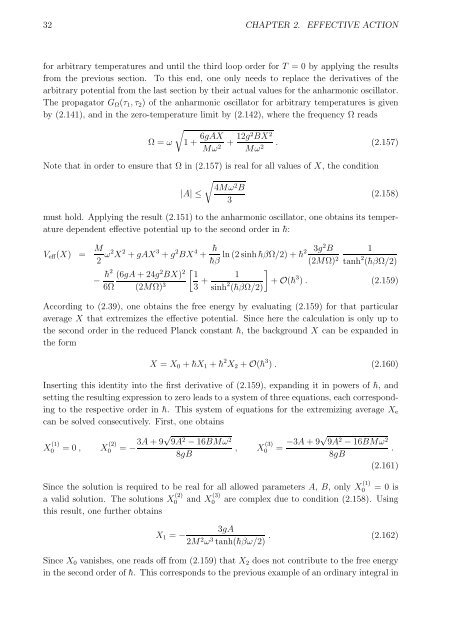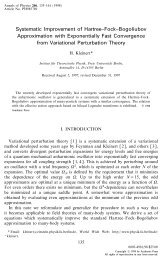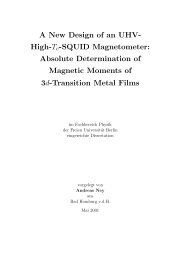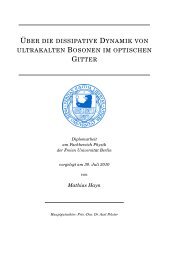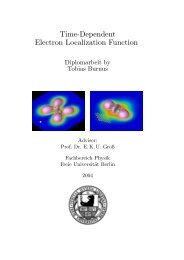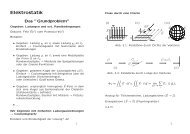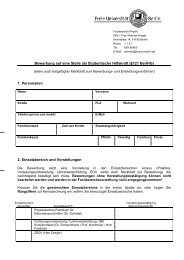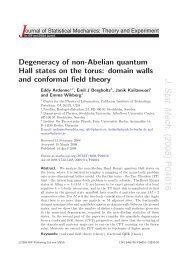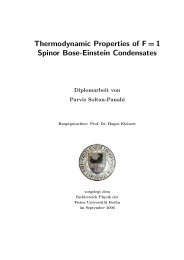Diploma thesis - Fachbereich Physik
Diploma thesis - Fachbereich Physik
Diploma thesis - Fachbereich Physik
Create successful ePaper yourself
Turn your PDF publications into a flip-book with our unique Google optimized e-Paper software.
32 CHAPTER 2. EFFECTIVE ACTION<br />
for arbitrary temperatures and until the third loop order for T = 0 by applying the results<br />
from the previous section. To this end, one only needs to replace the derivatives of the<br />
arbitrary potential from the last section by their actual values for the anharmonic oscillator.<br />
The propagator G Ω (τ 1 , τ 2 ) of the anharmonic oscillator for arbitrary temperatures is given<br />
by (2.141), and in the zero-temperature limit by (2.142), where the frequency Ω reads<br />
Ω = ω<br />
√<br />
1 + 6gAX<br />
Mω 2 + 12g2 BX 2<br />
Mω 2 . (2.157)<br />
Note that in order to ensure that Ω in (2.157) is real for all values of X, the condition<br />
|A| ≤<br />
√<br />
4Mω2 B<br />
3<br />
(2.158)<br />
must hold. Applying the result (2.151) to the anharmonic oscillator, one obtains its temperature<br />
dependent effective potential up to the second order in ¯h:<br />
V eff (X) = M 2 ω2 X 2 + gAX 3 + g 2 BX 4 + ¯h<br />
¯hβ<br />
ln (2 sinh ¯hβΩ/2) + ¯h2<br />
3g<br />
[<br />
− ¯h2 (6gA + 24g 2 BX) 2 1<br />
6Ω (2MΩ) 3 3 + 1<br />
sinh 2 (¯hβΩ/2)<br />
2 B<br />
(2MΩ) 2 1<br />
tanh 2 (¯hβΩ/2)<br />
]<br />
+ O(¯h 3 ) . (2.159)<br />
According to (2.39), one obtains the free energy by evaluating (2.159) for that particular<br />
average X that extremizes the effective potential. Since here the calculation is only up to<br />
the second order in the reduced Planck constant ¯h, the background X can be expanded in<br />
the form<br />
X = X 0 + ¯hX 1 + ¯h 2 X 2 + O(¯h 3 ) . (2.160)<br />
Inserting this identity into the first derivative of (2.159), expanding it in powers of ¯h, and<br />
setting the resulting expression to zero leads to a system of three equations, each corresponding<br />
to the respective order in ¯h. This system of equations for the extremizing average X e<br />
can be solved consecutively. First, one obtains<br />
X (1)<br />
0 = 0 , X (2)<br />
0 = − 3A + 9√ 9A 2 − 16BMω 2<br />
8gB<br />
, X (3)<br />
0 = −3A + 9√ 9A 2 − 16BMω 2<br />
.<br />
8gB<br />
(2.161)<br />
Since the solution is required to be real for all allowed parameters A, B, only X (1)<br />
0 = 0 is<br />
a valid solution. The solutions X (2)<br />
0 and X (3)<br />
0 are complex due to condition (2.158). Using<br />
this result, one further obtains<br />
3gA<br />
X 1 = −<br />
2M 2 ω 3 tanh(¯hβω/2) . (2.162)<br />
Since X 0 vanishes, one reads off from (2.159) that X 2 does not contribute to the free energy<br />
in the second order of ¯h. This corresponds to the previous example of an ordinary integral in


